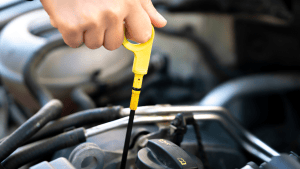Should I Check My Oil When the Engine is Hot or Cold? An Expert 101 Guide
Should I check my oil when engine is hot or cold?
Proper vehicle maintenance is key to keeping your engine running smoothly, and one crucial aspect is checking your oil regularly.
Regularly checking the oil level in your vehicle is an essential part of proper maintenance.
It ensures that your engine stays properly lubricated, reduces wear and tear, and helps prevent costly repairs down the line.
However, one of the most common questions car owners have when it comes to vehicle maintenance is, “Should I check my oil when engine is hot or cold?”
In this detailed guide, we’ll answer this question and provide insights on engine oil maintenance to help you keep your engine running smoothly.
Should I Check My Oil When Engine is Hot or Cold?
When it comes to the question, “Should I check my oil when engine is hot or cold?”, the ideal time to check your engine oil is when the engine is warm but not too hot.
This is because the oil expands as the engine heats up, providing a more accurate reading of the oil level.
To do this, wait about 5-10 minutes after turning off the engine before checking the oil level.
Checking the oil when the engine is cold may result in a lower reading due to the oil contracting while checking it when the engine is too hot can pose a risk of burns from hot engine components and may not provide an accurate reading.
By checking your oil when the engine is warm, you can ensure that your engine has the proper amount of oil, which is crucial for maintaining optimal performance and extending the lifespan of your vehicle.
Checking the Oil When The Engine Is Hot
When the engine has been running for some time and is at operating temperature, checking the oil can provide a more accurate measurement.
Here’s why:
a. Oil Circulation: When the engine is hot, the oil circulates more efficiently, ensuring that it reaches all the necessary components.
By checking the oil when it’s warm, you get a better representation of its level and quality throughout the system.
b. Proper Level: The warm engine allows the oil to settle to its normal level after circulation. This helps you gauge if the oil level is adequate or if it needs to be topped up.
c. Oil Thinness: Heat causes oil to thin out, making it easier to flow and giving you a clearer indication of its consistency.
Checking the oil when it’s hot allows you to assess if it’s still in good condition or if it has become excessively thin or degraded.
Checking the Oil When The Engine Is Cold:
Checking the oil when the engine is cold also has its advantages.
Consider the following points:
a. Safety: Cold oil poses less risk of burns or injuries during the oil checking process.
If you’re not comfortable working around hot engine components, checking the oil when the engine is cold might be a safer option for you.
b. Immediate Assessment: By checking the oil before starting the engine, you can quickly identify any major issues, such as extremely low oil levels or the presence of contaminants.
This immediate assessment can give you an early warning of potential problems.
c. Longer Drain Time: Allowing the engine to cool down overnight or for several hours before checking the oil can ensure that most of the oil has settled in the oil pan, providing a more accurate reading.
Some Common Questions
1. Is it OK to check oil when the engine is hot?
While it’s possible to check your oil when the engine is hot, it’s generally recommended to wait a few minutes after turning off the engine to let the oil settle.
This ensures more accurate reading and prevents potential burns from hot engine components.
2. What is the best engine temperature to check oil?
The ideal engine temperature for checking oil is when the engine is warm but not too hot.
This allows the oil to expand and provides a more accurate reading. Wait about 5-10 minutes after turning off the engine before checking the oil level.
3. Is oil level lower when cold?
Yes, the oil level may appear lower when the engine is cold because the oil has contracted.
As the engine warms up, the oil expands and provides a more accurate reading of the oil level.
4. Is oil level higher or lower when hot?
The oil level will generally be higher when the engine is hot due to the expansion of the oil.
This is why it’s important to check the oil when the engine is warm but not too hot.
5. Why check engine oil when warm?
Checking the engine oil when warm provides a more accurate reading of the oil level.
This is because the oil has expanded and settled, allowing for a better assessment of whether your engine has the proper amount of oil.
6. When should you check engine oil level?
It’s best to check your engine oil level regularly, at least once a month or before long trips.
This helps ensure your engine has the proper amount of oil and can prevent potential damage due to low oil levels.
7. Do you check oil with the car on or off?
Always check the oil with the car turned off. This allows the oil to settle and provides a more accurate reading.
8. Do you check diesel oil hot or cold?
Similar to gasoline engines, it’s best to check diesel engine oil when the engine is warm but not too hot.
Wait a few minutes after turning off the engine before checking the oil level.
9. Should I check my oil when engine is hot or cold for Honda and Toyota vehicles?
For both Honda and Toyota vehicles, it’s recommended to check the oil when the engine is warm but not too hot.
This ensures more accurate reading and helps maintain proper engine performance.
Do you check oil with car on or off?
When checking your oil, it is generally recommended to have the car turned off.
Here’s why:
- Accurate Measurement: With the engine off, the oil settles in the oil pan, providing a more accurate reading of the oil level. This allows you to determine if the oil level is within the recommended range.
- Safety: Checking the oil with the engine off reduces the risk of injury. Hot engine components can cause burns, and moving parts can be hazardous if the engine is running. Therefore, turning off the engine ensures a safer environment for inspecting the oil.
To check the oil with the engine off, follow these steps:
- Park your vehicle on a level surface and turn off the engine.
- Wait for a few minutes to let the engine cool down slightly if it has been running.
- Open the hood of your car and locate the dipstick. It is usually labeled and has a brightly colored handle.
- Pull the dipstick out of its tube completely.
- Wipe the dipstick clean using a cloth or paper towel, ensuring no oil droplets remain.
- Insert the dipstick back into its tube all the way, making sure it is fully seated.
- Pull the dipstick out again and observe the oil level, checking against the minimum and maximum markings.
- Examine the color and consistency of the oil, ensuring it appears clean and within the recommended specifications.
- If the oil level is below the minimum mark or if the oil appears dirty or degraded, consult your vehicle’s owner’s manual for the appropriate steps to take, such as adding oil or scheduling an oil change.
Remember, always prioritize safety when checking your oil. Keep the engine off, be cautious of hot engine components, and follow any specific instructions provided by your vehicle’s manufacturer.
Regularly checking and maintaining the oil level is vital for the health and performance of your engine
Check engine oil hot or cold Toyota
When it comes to checking the engine oil in a Toyota vehicle, it is generally recommended to check the oil when the engine is warm.
Toyota suggests following these steps:
- Park your Toyota on a level surface and turn off the engine.
- Allow the engine to idle for a few minutes to warm up the oil. This helps ensure that the oil is evenly distributed throughout the engine.
- Open the hood of your vehicle and locate the engine oil dipstick. It is typically labeled and has a brightly colored handle.
- Carefully pull out the dipstick and wipe it clean using a cloth or paper towel to remove any oil residue.
- Reinsert the dipstick all the way back into its tube, making sure it is fully seated.
- Pull out the dipstick again and observe the oil level and condition. The dipstick usually has markings indicating the minimum and maximum oil levels.
- Check the color and consistency of the oil. It should typically be amber or light brown and have a smooth texture. If the oil appears excessively dirty, gritty, or contains particles, it may be a sign that an oil change is necessary.
- Take note of the oil level on the dipstick. If the oil level is below the minimum mark, you may need to add oil. Consult your
- Toyota owner’s manual for the correct type and amount of oil to use.
Once you have completed the oil check, carefully reinsert the dipstick back into its tube.
It’s important to note that while warm engine oil is generally recommended for checking in a Toyota, it is crucial to ensure that the engine is not too hot to avoid burning yourself.
Additionally, always refer to your specific Toyota model’s owner’s manual for any manufacturer recommendations or guidelines regarding oil checks and maintenance.
Check engine oil hot or cold Honda
When checking the engine oil in a Honda vehicle, it is typically recommended to check the oil when the engine is warm.
Here are the steps to follow:
- Park your Honda on a level surface and turn off the engine.
- Allow the engine to idle for a few minutes to warm up the oil. This ensures that the oil has circulated throughout the engine and settled to its normal level.
- Open the hood of your vehicle and locate the engine oil dipstick. It is usually labeled and has a brightly colored handle.
- Carefully pull out the dipstick and wipe it clean with a cloth or paper towel to remove any oil residue.
- Reinsert the dipstick fully back into its tube, ensuring it is seated properly.
- Pull out the dipstick again and observe the oil level and condition. The dipstick typically has markings indicating the minimum and maximum oil levels.
- Check the color and consistency of the oil. It should appear amber or light brown and have a smooth texture. If the oil is excessively dark, dirty, or contains particles, it may be a sign that an oil change is needed.
- Take note of the oil level on the dipstick. If the oil level is below the minimum mark, you may need to add oil. Refer to your
- Honda owner’s manual for the correct type and amount of oil to use.
- Once you have completed the oil check, carefully reinsert the dipstick back into its tube.
While checking the engine oil when it is warm is the general recommendation for Honda vehicles, it is important to ensure that the engine is not too hot to avoid any potential burns.
Additionally, it is always advisable to consult your specific Honda model’s owner’s manual for any manufacturer guidelines or recommendations regarding oil checks and maintenance procedures.
Check oil hot or cold Subaru
When checking the engine oil in a Subaru vehicle, it is recommended to check the oil when the engine is warm.
Follow these steps to check the oil in your Subaru:
- Park your Subaru on a level surface and turn off the engine.
- Allow the engine to idle for a few minutes to warm up the oil. This ensures that the oil is evenly distributed throughout the engine.
- Open the hood of your vehicle and locate the engine oil dipstick. It is usually labeled and has a brightly colored handle.
- Carefully pull out the dipstick and wipe it clean using a cloth or paper towel to remove any oil residue.
- Reinsert the dipstick fully back into its tube, ensuring it is seated properly.
- Pull out the dipstick again and observe the oil level and condition. The dipstick typically has markings indicating the minimum and maximum oil levels.
- Check the color and consistency of the oil. It should appear amber or light brown and have a smooth texture. If the oil appears excessively dark, dirty, or contains particles, it may be an indication that an oil change is needed.
- Take note of the oil level on the dipstick. If the oil level is below the minimum mark, you may need to add oil. Refer to your
- Subaru owner’s manual for the correct type and amount of oil to use.
- Once you have completed the oil check, carefully reinsert the dipstick back into its tube.
It is important to note that checking the oil when the engine is warm allows for a more accurate assessment of the oil level and condition. However, make sure the engine is not too hot to avoid burns. As always, refer to your specific Subaru model’s owner’s manual for any manufacturer recommendations or guidelines regarding oil checks and maintenance.
Oil level in a car
The oil level in a car refers to the measurement of how much oil is present in the engine. Maintaining the proper oil level is crucial for the health and performance of the engine. Here are some key points to understand about oil levels in a car:
- Importance of Proper Oil Level: Engine oil plays a vital role in lubricating the internal components of the engine, reducing friction, and preventing excessive wear. It also helps in cooling and removing contaminants from the engine. Maintaining the proper oil level ensures effective lubrication and optimal engine performance.
- Checking the Oil Level: To check the oil level in your car, follow these general steps:
- a. Park your vehicle on a level surface and turn off the engine.
b. Locate the engine oil dipstick, which is usually labeled and has a brightly colored handle.
c. Pull out the dipstick and wipe it clean with a cloth or paper towel to remove any oil residue.
d. Reinsert the dipstick fully back into its tube, ensuring it is seated properly.
e. Pull out the dipstick again and observe the oil level. The dipstick typically has markings indicating the minimum and maximum oil levels.
f. If the oil level is below the minimum mark, you may need to add oil to bring it up to the recommended level. Consult your vehicle’s owner’s manual for the correct type and amount of oil to use. - Ideal Oil Level: The ideal oil level is typically indicated by a range between the minimum and maximum marks on the dipstick. It is important not to overfill or underfill the oil. Overfilling can lead to excessive pressure and foaming, while underfilling can result in insufficient lubrication.
- Regular Oil Checks: It is recommended to check the oil level regularly, ideally once a month or before long trips. Regular oil checks allow you to identify any significant changes in the oil level, which may indicate leaks, consumption, or other issues that require attention.
- Oil Consumption: Some vehicles may consume a small amount of oil over time due to normal engine operation. It is important to monitor the oil level and address excessive oil consumption if it occurs, as it may indicate underlying problems with the engine.
Remember, always refer to your vehicle’s owner’s manual for specific instructions and recommendations regarding checking and maintaining the oil level.
Following the manufacturer’s guidelines will help ensure proper engine performance and longevity.
Conclusion
The answer to the question, “Should I check my oil when engine is hot or cold?” is to check your engine oil when the engine is warm but not too hot.
This provides a more accurate reading and helps ensure your engine has the proper amount of oil.
Remember to check your oil regularly and follow the manufacturer’s guidelines for your specific vehicle make and model.
By doing so, you’ll keep your engine running smoothly and extend its lifespan.







